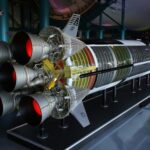Northrop Grumman and the U.S. Space Force achieved a first for the Deep-Space Advanced Radar Capability at Site 1 in Western Australia, synchronizing multiple ground antennas to act as one radar and track several satellites in geosynchronous orbit. Program officials described a multi-week integration push that culminated in coherent operation of the array and real satellite tracks from the site near Exmouth.
Seven of 27 antennas at DARC Site 1 track multiple satellites
Engineers brought seven of the site’s planned 27 parabolic antennas online as a unified sensor and used them to follow multiple spacecraft at roughly 36,000 kilometers (22,000 miles). That result confirms the core premise of DARC: smaller dishes can operate in concert and deliver the angular precison and sensitivity of a far larger radar. The company’s program lead for space surveillance, Kevin Giammo, underscored the scale of the step, noting that the array approach creates “the equivalent of a very large radar with immense capabilities.”
According to industry sources, the demonstration did more than produce a single snapshot. The team ran a campaign over several weeks, tuned calibration parameters then repeated tracking passes to validate stability. That sequence matched the integration plan and showed the array could hold calibration across sessions and targets. Defense officials confirm the event used a subset of the antennas to characterize satellite motion and to validate precision tracking modes before expanding to larger subarrays.
Giammo expanded on the program’s aim. “Northrop Grumman’s DARC will provide a strategic advantage at a scale never before achieved in global space domain awareness. Its ability to track multiple small moving objects over 22,000 miles above Earth will offer unmatched, persistent and comprehensive capability as the world’s premier deep-space radar tracking system,” he said. The comments align with the goal to extend custody of objects in GEO and monitor small, maneuvering satellites that strain current optical networks.
Site 1 demonstration results:
- Coherent operation of seven co-located dishes as a single radar aperture.
- Multiple GEO satellite tracks to validate pointing, timing, and processing chains.
- Sustained data collection and calibration to confirm repeatable performance.
Trilateral AUKUS radar network and 24/7 GEO coverage
DARC sits inside a trilateral framework that links the United States, the United Kingdom, and Australia. Site 1 occupies the Harold E. Holt precinct near Exmouth; Site 2 will stand in Wales; Site 3 will be in the continental United States at a location still under review. The second site moved ahead last year under a U.S. Space Force contract award to Northrop Grumman for roughly $200 million, with environmental and planning work in the UK already in train.
The network is intended to provide round-the-clock custody of objects in, to and from GEO – the belt that carries high-value satellites for communications, missile warning, and weather. Unlike optical systems, radar operates through daylight and cloud which is why partners chose it to complement existing space-surveillance assets in Australia and elsewhere.
Western Australia offers viewing geometry that improves sensitivity to otherwise hard-to-track orbital arcs. Combined with UK and U.S. nodes, the array reduces longitudinal coverage gaps. The Space Force has staged and tested major structures at Exmouth, including reflectors assembled in the Antenna Integration Structure. The site already hosts other SSA sensors such as the Space Surveillance Telescope; DARC adds an all-weather radar layer to that cluster.
Schedule, milestones and independent oversight
The schedule has shifted. U.S. Space Force statements now target Site 1 operations in 2027, following construction and early integration in 2024. That timeline reflects open-air transmit events and phased integration through 2024-2025.
GAO updates indicate Site 1 delays are pushing follow-on work at Sites 2 and 3 into the late 2020s and early 2030s. The program cites funding profiles and knock-on effects from the first site as the drivers.
Program summaries link completion in Australia to full system capability around the next decade. Budget and oversight documents lay out interim steps: initial operations at Site 1, design carryover into Site 2 and a later U.S. site decision after enviromental and airspace reviews. Those documents also flag the technical load-integrating RF hardware, digital beamforming, and high-rate processing across three locations under national and local review.
Oversight is central, as the network will feed operational picture tools and national command systems. The Wales award established a second anchor and started long-lead design; Site 3 remains unnamed. Partners continue to spell out data-sharing and sovereign-control rules under AUKUS while keeping techincal work at Site 1 on track.
Multi-antenna coherence, calibration campaign, and mission load
DARC’s antennas don’t operate on its own, but on a coherent array. In the Site 1 demo, the team aligned timing, phase, and pointing across seven dishes and concentrated energy on targets to lift signal-to-noise at GEO ranges. The radar ran common waveforms and a calibration loop that measured system errors, applied corrections, and held those settings over repeated passes. That sequence verified the processing stack-transmit control, receive-chain linearity, synchronization, and back-end correlation.
As more dishes join, the effective aperture grows, beams narrow, and sensitivity improves. Engineers can split beams for wide-area search while refining tracks with added dwell and waveform agility. The approach supports custody of small, maneuvering satellites that complicate prediction and allows rapid tasking to inspect high-interest objects that change attitude or drift within station-keeping boxes. Defense officials said the team will step up subarray sizes in coming integration events and target full 27-antenna operation at Site 1.
Radar’s all-weather performance drives persistence. GEO tracking continues through daylight, cloud, and smoke-conditions that limit optical systems. A coherent radar layer provides uniform coverage across day-night cycles and steady cues to other sensors, helping deconflict tracks, tighten conjunction screening, and build behavioral profiles for satellites of interest.
What operators gain as the array scales:
- Higher precision for ephemeris updates and maneuver detection.
- Greater capacity to hold more objects on track simultaneously.
- Reliable surveillance in weather and daylight, which stabilizes custody over weeks.
Northrop Grumman’s program lead said the architecture uses many “affordable” antennas instead of a single monolithic dish. The approach supports modular construction, repeatable integration and field maintenance. It also spreads risk: one antenna offline does not sideline the array, and calibration tools trim element-to-element variation. At Site 1, reflectors and subassemblies staged under the integration shelter show how the modular path accelerates once the toolchain stabilizes.
The August demonstration addressed the hardest task first: coherent multi-antenna deep-space tracking on operational targets. It enables scaling to the full 27-antenna array at Site 1 and informs Site 2 engineering in Wales. It also adds an all-weather radar layer to trilateral space domain awareness. Remaining risk centers on schedule, site approvals and the handoff from integration teams to steady-state operators. Partners plan to expand subarrays, tune processing and start routine cross-cueing with existing optical systems in Western Australia as those milestones approach.
REFERENCE SOURCES
- https://www.ssc.spaceforce.mil/Portals/3/SSC%20DARC%20SITE%202%20AWARD%20FINAL%208_26_2024.pdf
- https://breakingdefense.com/2025/08/northrop-grumman-says-first-darc-test-validates-radar-tracking-capability/
- https://www.defensenews.com/space/2025/08/15/deep-space-radar-hits-key-testing-milestone/
- https://www.janes.com/osint-insights/defence-news/defence/northrop-grumman-demonstrates-darc-site-1-capabilities
- https://spacenews.com/deep-space-radar-in-australia-begins-tracking-satellites-for-aukus-partners/
- https://www.spaceforce.mil/News/Article-Display/Article/4072069/deep-space-advanced-radar-capability-makes-tremendous-progress-in-first-year/
- https://www.vandenberg.spaceforce.mil/News/Article-Display/Article/4072069/deep-space-advanced-radar-capability-makes-tremendous-progress-in-first-year/
- https://euro-sd.com/2025/08/major-news/45952/darc-multiple-antennas-tested/
- https://spacenews.com/space-force-awards-200-million-contract-to-northrop-grumman-for-uk-radar-site/
- https://insidedefense.com/insider/darc-completes-first-space-domain-awareness-demo
- https://www.everythingrf.com/news/details/20645-northrop-grumman-develops-multi-antenna-deep-space-radar-for-satellite-tracking
- https://thedefensepost.com/2025/08/18/northrop-us-space-radar-demo/



